Why more Indians are crossing borders illegally to enter the US
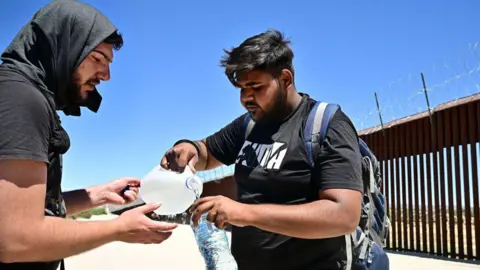 AFP
AFPIn October, US Immigration and Customs Enforcement (Ice) sent a chartered flight carrying Indian nationals back home, marking a growing trend in deportations to India.
This was no ordinary flight – it was one of multiple large-scale “removal flights” carried out this year, each typically carrying more than 100 passengers. The flights were returning groups of Indian migrants who “did not establish a legal basis to remain in the US”.
According to US officials, the latest flight carrying adult men and women was routed to Punjab, close to many deportees’ places of origin. No precise breakdown of hometowns was provided.
In the US fiscal year 2024 which ended in September, more than 1,000 Indian nationals had been repatriated by charter and commercial flights, according to Royce Bernstein Murray, assistant secretary at the US Department of Homeland Security.
“That has been part of a steady increase in removals from the US of Indian nationals over the past few years, which corresponds with a general increase in encounters that we have seen with Indian nationals in the last few years as well,” Ms Murray told a media briefing. (Encounters refer to instances where non-citizens are stopped by US authorities while attempting to cross the country’s borders with Mexico or Canada.)
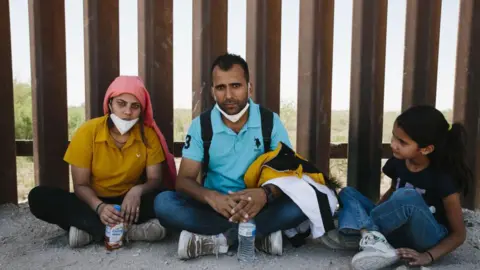 Getty Images
Getty ImagesAs the US ramps up repatriations of Indian nationals, concerns grow about how President-elect Donald Trump’s immigration policies will affect them. Trump has already promised the biggest deportation of migrants in history.
Since October 2020, US Customs and Border Protection (CPB) officials have detained nearly 170,000 Indian migrants attempting unauthorised crossings at both the northern and southern land borders.
“Though smaller than the numbers from Latin America and the Caribbean, Indian nationals represent the largest group of migrants from outside the Western Hemisphere encountered by the CPB in the past four years,” say Gil Guerra and Sneha Puri, immigration analysts at Niskanen Center, a Washington-based think tank.
As of 2022, an estimated 725,000 undocumented Indian immigrants were in the US, making them the third-largest group after those from Mexico and El Salvador, according to new data from the Pew Research Center. Unauthorised immigrants in all make up 3% of US’s total population and 22% of the foreign-born population.
Looking at the data, Mr Guerra and Ms Puri have identified notable trends in the spike in Indians attempting illegal border crossings.
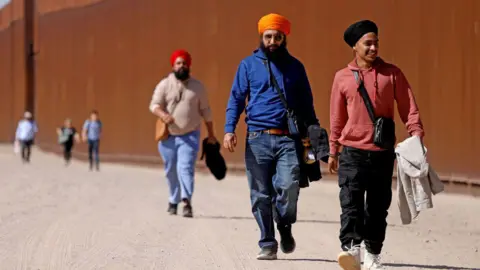 Getty Images
Getty ImagesFor one, the migrants are not from the lowest economic strata. But they cannot secure tourist or student visas to the US, often due to lower education or English proficiency.
Instead, they rely on agencies charging up to $100,000 (£79,000), sometimes using long and arduous routes designed to dodge border controls. To afford this, many sell farms or take out loans. Not surprisingly, data from the US immigration courts in 2024 reveals that the majority of Indian migrants were male, aged 18-34.
Second, Canada on the northern border has become a more accessible entry point for Indians, with a visitor visa processing time of 76 days (compared to up to a year for a US visa in India).
The Swanton Sector – covering the states of Vermont and counties in New York and New Hampshire – has experienced a sudden surge in encounters with Indian nationals since early this year, peaking at 2,715 in June, the researchers found.
Earlier, most irregular Indian migrants entered the Americas through the busier southern border with Mexico via El Salvador or Nicaragua, both of which facilitated migration. Until November last year, Indian nationals enjoyed visa-free travel to El Salvador.
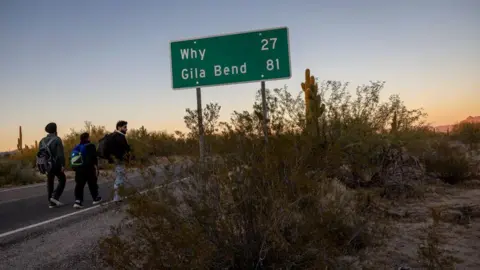 AFP
AFP“The US-Canada border is also longer and less guarded than the US-Mexico border. And while it is not necessarily safer, criminal groups do not have the same presence there as they do along the route from South and Central America,” Mr Guerra and Ms Puri say.
Thirdly, much of the migration appears to originate from the Sikh-dominated Indian state of Punjab and neighbouring Haryana, which has traditionally seen people migrating overseas. The other source of origin is Gujarat, the home state of Indian Prime Minister Narendra Modi.
Punjab, which accounts for a large share of irregular Indian migrants, is facing economic hardships, including high unemployment, farming distress and a looming drug crisis.
Migration has also long been common among Punjabis, with rural youth still eager to move abroad.
A recent study of 120 respondents in Punjab by Navjot Kaur, Gaganpreet Kaur and Lavjit Kaur found that 56% emigrated between ages 18-28, often after secondary education. Many funded their move through non-institutional loans, later sending remittances to their families.
Then there has been a rise in tensions over the separatist Khalistan movement, which seeks to establish an independent homeland for Sikhs. “This has caused fear from some Sikhs in India about being unfairly targeted by authorities or politicians. These fears may also provide a credible basis for claims of persecution that allows them to seek asylum, whether or not true,” says Ms Puri.

But pinning down the exact triggers for migration is challenging.
“While motivations vary, economic opportunity remains the primary driver, reinforced by social networks and a sense of pride in having family members ‘settled’ in the US,” says Ms Puri.
Fourth, researchers found a shift in the family demographics of Indian nationals at the borders.
More families are trying to cross the border. In 2021, single adults were overwhelmingly detained at both borders. Now, family units make up 16-18% of the detentions at both borders.
This has sometimes led to tragic consequences. In January 2022, an Indian family of four – part of a group of 11 people from Gujarat – froze to death just 12m (39ft) from the border in Canada while attempting to enter the US.
Pablo Bose, a migration and urban studies scholar at the University of Vermont, says Indians are trying to cross into the US in larger numbers because of more economic opportunities and “more ability to enter the informal economies in the US cities”, especially the large ones like New York or Boston.
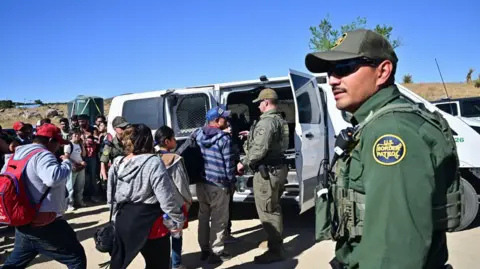 Getty Images
Getty Images“From everything I know and interviews I have conducted, most of the Indians are not staying in the more rural locations like Vermont or upstate New York but rather heading to the cities as soon as they can,” Mr Bose told the BBC. There, he says, they are entering mostly informal jobs like domestic labour and restaurant work.
Things are likely to become more difficult soon. Veteran immigration official Tom Homan, who will be in charge of the country’s borders following Trump’s inauguration in January, has said that the northern border with Canada is a priority because illegal migration in the area is a “huge national security issue”.
What happens next is unclear. “It remains to be seen if Canada would impose similar policies to prevent people migrating into the US from its borders. If that happens, we can expect a decline in detentions of Indians nationals at the border,” says Ms Puri.
Whatever the case, the dreams driving thousands of desperate Indians to seek a better life in the US are unlikely to fade, even as the road ahead becomes more perilous.
